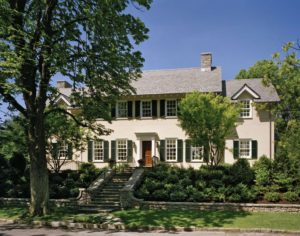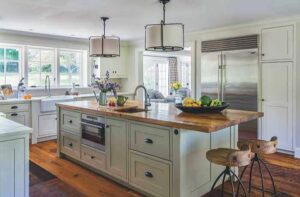Fun House
April 13, 2015
Text by Maria LaPiana Photography by Laura Moss Produced by Karin Lidbeck Brent
Surely Jonathan Bee must have a serious side. After all, he has worked in social services for most of his adult life; he runs two businesses; he writes. He’s a filmmaker, too, having just completed his first documentary, Paper Trail, which examines the effects of technology on creativity.
It takes a serious thinker to balance so many pursuits, but you’d never know it by looking at his Washington cottage—what he calls his “700-square-foot dollhouse”—where every room, every nook, niche, and cranny is filled with fanciful decorating turns and caprice.
This is where Bee’s inner artist lives. “In my free time I like to design and create small spaces that have a poetic feeling,” he says.
So when he discovered that the house was for sale, he jumped at it. “I was looking for a small house, a studio to do my art work in,” he remembers. “I saw a listing for an artist cottage and when I saw this romantic, rundown bungalow from the 1940s,
I saw its raw potential just begging to be revived.”
It has become his “Tuesday–Wednesday house,” he says. “I come up Monday nights and usually have dinner at Community Table, which is such a treat, and then I bunker in and work on all my creative projects.”
The rest of the time, Bee lives in nearby Sharon, with his partner, Kent Hunter, with whom he runs Hunter Bee, an antiques store in Millerton, New York.
While it was the scale of the cottage that appealed to him, Bee knew he’d have to devise ways to make it not feel too close. “It was a great challenge to make a small space feel big,” he says. “There is a wonderful intimacy in a small space that demands your attention at all times. Small details really make a difference. I know lots of decorators say if you want to make a space feel big, paint the whole room white—but kill me first!”
The building’s floor plan is U-shaped, and the front door opens directly onto the living room. Bee maximized the space by designing a daybed/sofa with bookshelves on both sides. The thoughtful placement of furnishings and treasured collectibles goes a long way toward making the cottage feel much more spacious than it is. “I love being eclectic, so I found lots of antique pieces that had storage and character,” he says. Inspired by the practical compactness of a ship’s cabin, he made room to store linens, pillows, and anything out-of-season inside cabinets, on shelves, and hidden under benches. “I made this house seem as large as my 7,000-square-foot house in Sharon,” he says.
Now that may be a stretch, but it’s clear Bee has a knack for putting things together in unusual ways. His strategy? Mix fun collections with artwork to stimulate the eye, but not overpower. “It’s a delicate dance,” he says. “I created a million little stories that are just waiting to be discovered again and again. Each room was fun and challenging. When something felt like it was getting too serious, I’d try and make it a bit lighter. That’s why I used a woodland scene for my bedroom wallpaper. I like things to be nostalgic and current. I hope I succeeded in this space.”
Orchestrating so many pieces in a small space can be daunting, Bee admits, “but that’s the fun of decorating. It’s your home at the end of the day. And the joy of being surrounded by all the things you love is comforting. I hate it when someone comes into my antique shop and loves something…but has to call their decorator first for their approval.”
There are surprises at every turn: an old metal watch sign that’s been converted into a mirror, a bust covered in newspaper, a stone deer on a Chippendale demilune table, a Lalique sculpture next to a framed Woodstock stamp, a small black-and-white picture of Charlie Chaplin that isn’t Chaplin at all, but an impersonator. “I love that picture,” says Bee.
It was important that added fixtures and architectural details feel authentic. “I remember searching fifty stores until I found the perfect light fixture for the kitchen,” he says. He installed a stained-glass window in the door to the attic to create light in a dark hallway. He built an old altar box into a wall. He hung an old carved wood door in the bathroom with mirrors on both sides “for more light and the illusion of space.”
While fun is good, comfort is even better. “I think a space should be comfortable, but that’s subjective. Some people love living in a concrete box,” he says. “For me, I love to know that there are nooks to sit in and pillows to grab.”
As a fiber artist (he owns a knitting bag company called Wooly Bully), Bee has a passion for textiles, and for brazenly mixing color, texture, and pattern. He let loose in the living room, where he used reclaimed wood to cover the fireplace wall. “My contractor said, ‘I take that stuff down, not put it up,’” he recalls. “I said, ‘Trust me.’”
Crazy about the toile curtains that came with the house, he found some vintage hand-painted wallpaper to go with them, and yet another living room wall is covered with vintage silk grasscloth. “Everyone thought I was nuts, that the patterns would clash, but in fact they dance together in a surprising and joyful way,” he says.
Works of art are showcased in each room (many pieces created by friends, making them all the more meaningful), as are Bee’s myriad collections. “I also wanted a place that showcased my favorite possessions and art collection,” he says. “I love small collections. I have a million, from teapots to dice. The hunt is always fun. I have four barns filled with treasures.
I just can’t stop.” •
Interior Design: Jonathan Bee
Share
![NEH-Logo_Black[1] NEH-Logo_Black[1]](https://www.nehomemag.com/wp-content/uploads/2022/08/NEH-Logo_Black1-300x162.jpg)



















You must be logged in to post a comment.